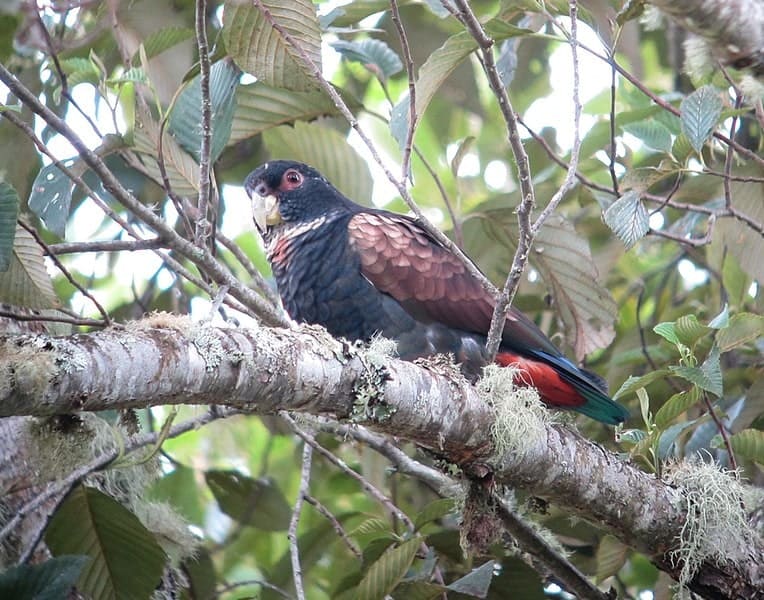The Bronze-winged Pionus is very beautiful! The attractive, though subtle, coloring in its plumage is especially apparent in bright light, and the vivid blues on the undersides of the wings can be seen when they fly if kept in an aviary.
Being curious, personable, and quite intelligent, the Bronze-winged Pionus makes a wonderful family pet. They are also a great pet for people who live in apartments or in close proximity to neighbors (where noise can be a problem) because they have a relatively quiet calm personality.
- For information about the care of Pionus Parrots see: Guide to a Happy, Healthy Pionus
Scientific Classification
| Kingdom: | Animalia |
| Phylum: | Chordata |
| Class: | Aves |
| Order: | Psittaciformes |
| Family: | Psittacidae |
| Genus: | Pionus |
| Species: | chalcopterus |
Scientific Name
Pionus chalcopterus
(A subspecies of Bronze-winged Pionus P. c. cyanescens was described in 1944 by Meyer de Schauense, however as of 2001, ornithologists tend to view it as identical to the nominate species Pionus chalcopterus.)
Distribution
These birds are native to the mountainous regions of northwest Venezuela, western Columbia, Ecuador, and northwest Peru. They inhabit forests in the tropical and sub-tropical zones.
Description
The Bronze-winged Pionus is a medium-sized stocky parrot with a wonderful personality. Their overall appearance is a dark violet-blue with a white chin, pink tips to the feathers on the throat, and a bronze dusting to the wings. There are many subtle blendings of colors overall. The head, neck, upper back, wings, and upper tail have bronze to bronze-green feathers tipped with blues to purple-blues, while the feathers on the underparts are dark green tipped with violet-blues. The lower back, rump, and tail are a deep blue with the undertail having the bright red feathers distinguishable to all the pionus. The underwings are a blue to bluish-green and the legs are brown. Their beak is yellowish, the eye brown, and their eye ring is a variable greyish.
Juveniles have much less developed color variety and are more greenish overall. The eye ring is yellowish rather than greyish pink.
Size – Weight
These birds grow to a length of 11″ (28 cm).
Care and feeding
A roomy cage is required unless the bird is to be let out for extended periods. Many birds can spend a good deal of their time on a play pen or parrot perch. The Bronze-winged Pionus should not be kept outdoors where temperatures fall below 41° F (5° C).
They eat a variety of seeds, fruits, berries, and greenstuffs. Including a formulated diet would also be beneficial.
- See About Pionus: Housing and About Pionus: Care and Feeding for more information.
Social Behaviors
These birds tame very easily and are very sociable. They are not loud like many conures and amazons. They have very steady personalities and do not tend to bite.
- See About Pionus: Social Behaviors for information on developing a well rounded pionus.
Breeding/Reproduction
There is no visible means of sexing these birds, though their eye rings will turn a darker pink during breeding season. The Bronze-winged Pionus form a very strong pair bond, sometimes resulting in over-zealous preening and plucking around the back of each others’ necks.
They are a relatively difficult bird to breed as they tend to be rather nervous. A nest box should be approximately 10″ x 10″ x 24″ (26 x 26 x 62 cm) and to encourage breeding, placed it high up in a dark area of the aviary.
The female will lay 4 to 5 eggs which incubate for about 26 days. Pairs may take mealworms and greenstuffs when they have chicks in the nest. Corncob is a favorite weaning food. The young leave the nest in the wild after about 8 weeks but can take a little longer in captivity, up to about 10 weeks.
- See About Pionus: Breeding/Reproduction for more information on breeding.
Potential Problems
The Bronze-winged Pionus is a relatively healthy bird, though the pionus parrots have been known to be more susceptible to the infection aspergillosis than other species. The main symptom is heavy, belabored breathing.
- See About Pionus: Potential Problems for information on health.
Availability
This bird is available from time to time. Though they are relatively common in captivity, the Bronze-winged Pionus are not as widespread in the pet trade and so not as frequently available as some of the other pionus.
The most frequently available pionus are the Blue-headed Pionus, the White-crowned Pionus, and the Maximilian’s Pionus.
Pionus chalcopterus (Image Credit: Félix Uribe, Wikimedia Commons CC SA 2.0 Generic)
